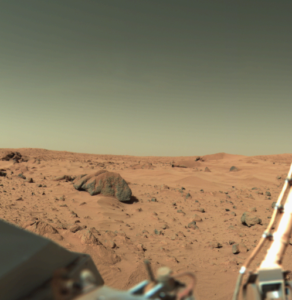We might see manned trips to the red planet in our lifetimes. Last week, President Obama called for the U.S. to get its astronauts to Mars and back within the next 15-20 years.
It’s the same vision he laid out in 2010. But this time, it comes with promising plans. NASA has contracted with six companies to create long-term habitats that could sustain human life during a long-term mission to Mars.
Sciencing the &#*! out of things is going to happen after all.
Of course, the scientific community is reacting to Obama’s call with a mixture of interest and caution. Dr. Jamie Molaro, Postdoctoral Fellow at the NASA-Jet Propulsion Laboratory, is looking forward to seeing what happens next.

Dr. Jamie Molaro of
NASA’s Jet Propulsion Lab
“Recent robotic missions to Mars have really helped capture the public’s imagination, and human space exploration is something that a lot of people get really excited about,” Molaro says. “With private industries and space programs in other countries catching up with us, I’m not surprised there’s a push to make sure NASA stays relevant and that we are part of the new space age.”
Like any sci-fi fan, Molaro loves the thought of seeing fiction turn into science fact. “Part of me gets excited about the sci-fi I love, thinking about whizzing around in spaceships and visiting settlements on planets across the galaxy,” she says. But the romance of that vision will only happen, she notes, as our technology improves. And that will take work…and monetary support for all the sciences involved in making space travel viable.
“To me, exploration is about learning about our solar system, not just traveling it,” Molaro says. “In order to get actual science, robotic space exploration is drastically more cost efficient. So, personally, I’d like to see more money spent on science missions, while we continue to develop human spaceflight capability and technology in the Earth-Moon system.”
Overall, though, Molaro is like most people — curious to see what happens and happy to see the public’s interest in space exploration rising.
“There are many opinions on this within the science community and the public,” she says. “Overall, I’m just glad to see growing interest throughout the world in space and space science.”
We couldn’t agree more.
Disclaimer: The views and opinions expressed here by Dr. Jamie Molaro are her own, and do not necessarily reflect the views, policies, or official position of the NASA-Jet Propulsion Laboratory or NASA in general.

Mars surface, photo taken by the Viking Lander 1 on February 11, 1978